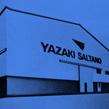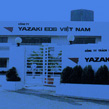Ceremony marking the opening of Thai Yazaki Electric Wire (1962)
Episodes in Yazaki’s global expansion
In this section, see various episodes in Yazaki’s
global expansion at a time when few Japanese companies did business overseas.
HOME Episodes in Yazaki’s global expansion American Yazaki steps forward at a time when “Made in Japan” had a poor reputation.

1966 U.S.A.
American Yazaki steps forward at a time when “Made in Japan” had a poor reputation.

Yazaki enters the US before all others
On December 8, 1966, American Yazaki Corporation (AYC) was born in Chicago, Illinois. It was established with $50,000 (18 million yen) in capital, the entire amount of which was supplied by Yazaki Corporation. Its business consisted of sales and import/export of: 1) electric wires and cables, 2) instruments and gauges, 3) automotive parts, and 4) synthetic resin products and electric devices.
Ceremonies announcing AYC’s establishment were held in two cities, New York and Chicago, in February of the following year. Local clients, other Japanese companies doing business in the United States, trading companies, banks, government officials and others were invited to attend. The New York ceremony was held at the Hotel Americana on February 7 and was attended by some 200 invitees. In Chicago, the ceremony was held at the Edgewater Beach Hotel on February 10 and was attended by approximately 150 invitees.
Thus, AYC was off to a spectacular start. Of course, this start did not come with any orders from the Big Three automakers of GM, Ford, and Chrysler. AYC was a small operation with a staff of just seven that included three employees sent from Japan and female staffers. It was a time when very few Japanese companies―and even fewer manufacturers―did business in the American market. There were still no Japanese cars on the streets, and transistor radios and cameras were only just beginning to sell.
One young 23-year-old employee who had been posted to AYC from Shimada Seisakusho was given a highly important mission: To have technology tested and approved for sales of tachometers to Ford. However, the label “Made in Japan” had a poor reputation in those days, and Ford would not even let AYC’s technology be tested. However, after two years, the technology was finally approved, and Yazaki’s founder, Sadami Yazaki, took it upon himself to begin negotiations for orders. But then, suddenly, there was a change in specifications, and the negotiations were off. Having come all the way from Japan, Sadami was seething with anger. But when they returned to the parking lot and the young employee began crying in frustration, Sadami said, “Don’t cry. That happens in business sometimes.” Today, that employee says he will never forget the frustration or the deep emotion he felt at that time.
A win for the Japanese way of working together
In 1989, 23 years after AYC was founded, Yazaki EDS Engineering, Inc. was established to handle development and design in Detroit, U.S.A.
The person in charge at that time, who selected some ten young engineers and sent them to Detroit as the advance team, remembers that time as follows.
“In Japan, the standard practice is to have Yazaki personnel in the car manufacturer’s office so that both sides can develop the entire system together. However, in the United States, the car manufacturer separated the wire harness from the system, and then asked us to develop it. But when the Americans compared the two styles, they found that the Japanese way had more advantages.”
However, he always worried about the people he sent. In the United States, where they would be out of their element, the Japanese engineers would have to prepare the most cost-effective drawings while meeting face-to-face with the manufacturer’s engineers, and listening to and arguing about the specs of equipment to be wired. Thus, even if they had no problems in terms of technical ability, he was concerned about whether they could stand up for themselves against people with a different language and customs.
“Counting on the youth and challenging spirit of those men in their twenties and thirties, I sent them to an intensive English training course and then to the United States. I heard that all of them had difficulty in the beginning, suffering from feelings of hardship or failure that they couldn’t share with others. Some felt frustrated with their language difficulties, while others went to the airport in the evening and watched the planes while thinking of home. But when I was sent to take charge two years later, I found that they were guiding the local staffers and effectively working with clients, and that they were full of confidence, knowing that they had earned people’s trust.”
People grow in the environment in which they are placed, and with the responsibilities they are given. The practice of having employees build their experience in their workplace, even if they face major disadvantages, is a Yazaki tradition that remains strong to this day.
EPISODE SELECTION
EPISODE 01 Yazaki takes its first step overseas to Thailand before the Tokyo Olympics.
EPISODE 03 American Yazaki steps forward at a time when “Made in Japan” had a poor reputation.
EPISODE 04 Yazaki is the first to enter the European market! Offense is the best defense.
EPISODE 06 Yazaki’s arrow mark makes its appearance in Gaia, Portugal.
EPISODE 07 Demonstrate and then let others take over: The Yazaki Way takes root in Vietnam.
EPISODE SELECTION















